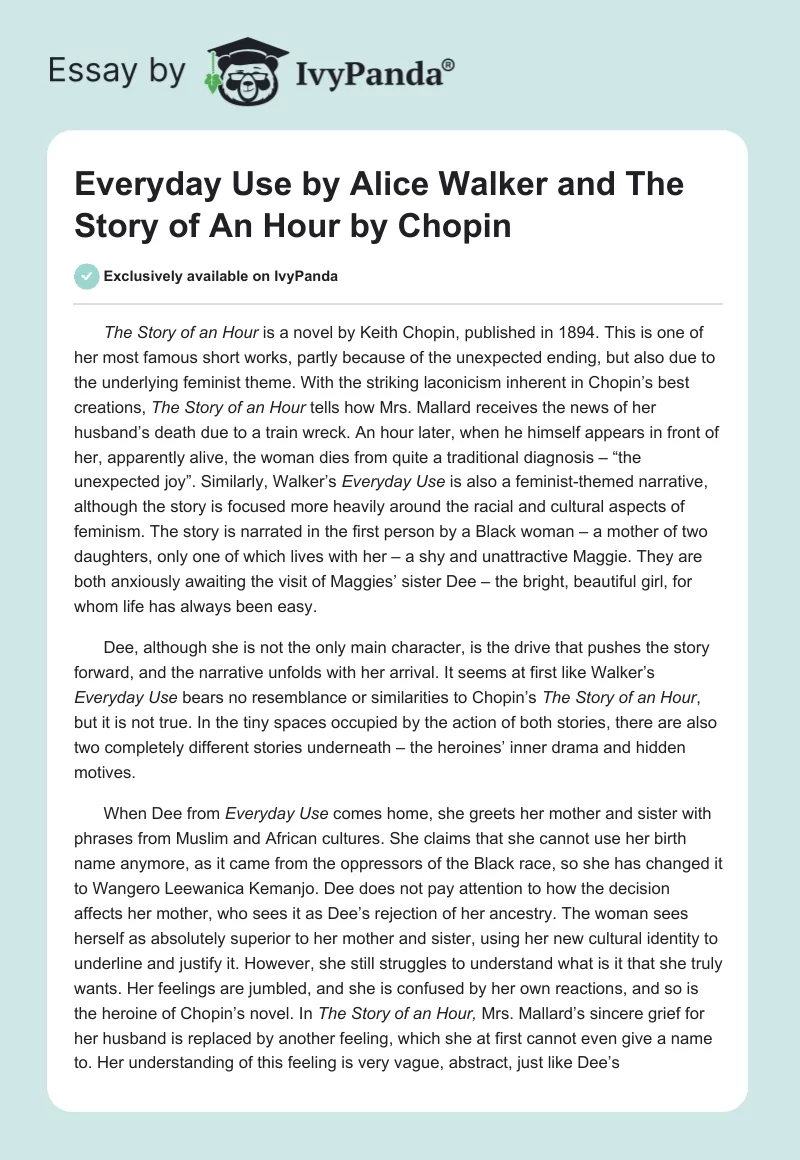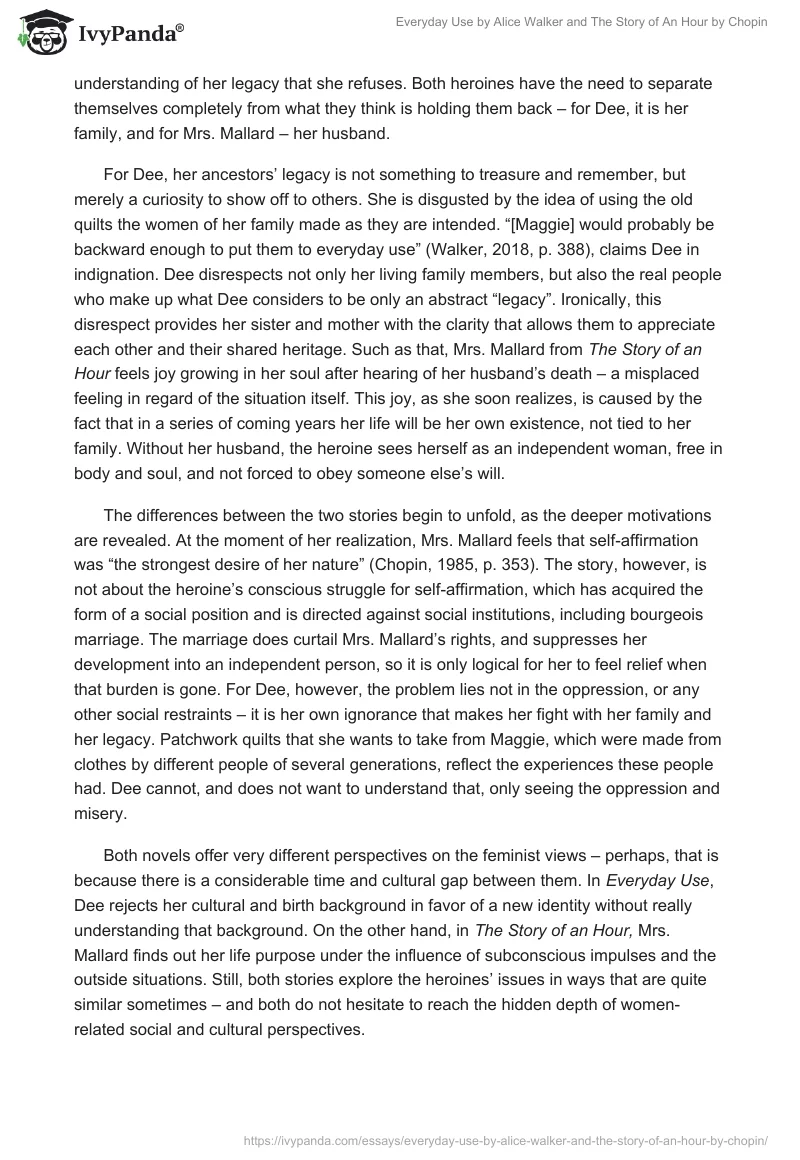The Story of an Hour is a novel by Keith Chopin, published in 1894. This is one of her most famous short works, partly because of the unexpected ending, but also due to the underlying feminist theme. With the striking laconicism inherent in Chopin’s best creations, The Story of an Hour tells how Mrs. Mallard receives the news of her husband’s death due to a train wreck. An hour later, when he himself appears in front of her, apparently alive, the woman dies from quite a traditional diagnosis – “the unexpected joy”. Similarly, Walker’s Everyday Use is also a feminist-themed narrative, although the story is focused more heavily around the racial and cultural aspects of feminism. The story is narrated in the first person by a Black woman – a mother of two daughters, only one of which lives with her – a shy and unattractive Maggie. They are both anxiously awaiting the visit of Maggies’ sister Dee – the bright, beautiful girl, for whom life has always been easy.
Dee, although she is not the only main character, is the drive that pushes the story forward, and the narrative unfolds with her arrival. It seems at first like Walker’s Everyday Use bears no resemblance or similarities to Chopin’s The Story of an Hour, but it is not true. In the tiny spaces occupied by the action of both stories, there are also two completely different stories underneath – the heroines’ inner drama and hidden motives.
When Dee from Everyday Use comes home, she greets her mother and sister with phrases from Muslim and African cultures. She claims that she cannot use her birth name anymore, as it came from the oppressors of the Black race, so she has changed it to Wangero Leewanica Kemanjo. Dee does not pay attention to how the decision affects her mother, who sees it as Dee’s rejection of her ancestry. The woman sees herself as absolutely superior to her mother and sister, using her new cultural identity to underline and justify it. However, she still struggles to understand what is it that she truly wants. Her feelings are jumbled, and she is confused by her own reactions, and so is the heroine of Chopin’s novel. In The Story of an Hour, Mrs. Mallard’s sincere grief for her husband is replaced by another feeling, which she at first cannot even give a name to. Her understanding of this feeling is very vague, abstract, just like Dee’s understanding of her legacy that she refuses. Both heroines have the need to separate themselves completely from what they think is holding them back – for Dee, it is her family, and for Mrs. Mallard – her husband.
For Dee, her ancestors’ legacy is not something to treasure and remember, but merely a curiosity to show off to others. She is disgusted by the idea of using the old quilts the women of her family made as they are intended. “[Maggie] would probably be backward enough to put them to everyday use” (Walker, 2018, p. 388), claims Dee in indignation. Dee disrespects not only her living family members, but also the real people who make up what Dee considers to be only an abstract “legacy”. Ironically, this disrespect provides her sister and mother with the clarity that allows them to appreciate each other and their shared heritage. Such as that, Mrs. Mallard from The Story of an Hour feels joy growing in her soul after hearing of her husband’s death – a misplaced feeling in regard of the situation itself. This joy, as she soon realizes, is caused by the fact that in a series of coming years her life will be her own existence, not tied to her family. Without her husband, the heroine sees herself as an independent woman, free in body and soul, and not forced to obey someone else’s will.
The differences between the two stories begin to unfold, as the deeper motivations are revealed. At the moment of her realization, Mrs. Mallard feels that self-affirmation was “the strongest desire of her nature” (Chopin, 1985, p. 353). The story, however, is not about the heroine’s conscious struggle for self-affirmation, which has acquired the form of a social position and is directed against social institutions, including bourgeois marriage. The marriage does curtail Mrs. Mallard’s rights, and suppresses her development into an independent person, so it is only logical for her to feel relief when that burden is gone. For Dee, however, the problem lies not in the oppression, or any other social restraints – it is her own ignorance that makes her fight with her family and her legacy. Patchwork quilts that she wants to take from Maggie, which were made from clothes by different people of several generations, reflect the experiences these people had. Dee cannot, and does not want to understand that, only seeing the oppression and misery.
Both novels offer very different perspectives on the feminist views – perhaps, that is because there is a considerable time and cultural gap between them. In Everyday Use, Dee rejects her cultural and birth background in favor of a new identity without really understanding that background. On the other hand, in The Story of an Hour, Mrs. Mallard finds out her life purpose under the influence of subconscious impulses and the outside situations. Still, both stories explore the heroines’ issues in ways that are quite similar sometimes – and both do not hesitate to reach the hidden depth of women-related social and cultural perspectives.
References
Chopin, K. (1895). The Story of an Hour. St. Louis Life.
Walker, A. (2020). [Fiction] Everyday use, by Alice Walker. Harper’s Magazine. Web.


